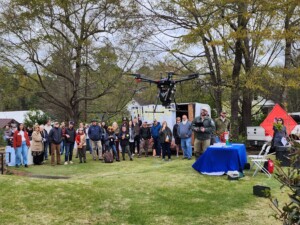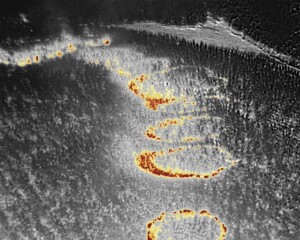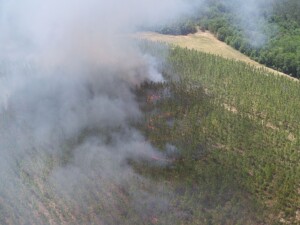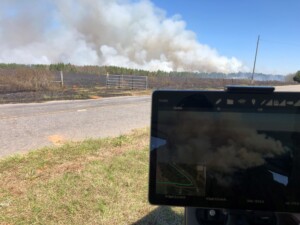
High-flying Tools for Fire – and More!
By RT Lumpkin, GFC Prescribed Burn Center Coordinator
Science and technology are critical tools utilized daily by the Georgia Forestry Commission. One such tool we are strategically moving forward with is UAS – Unmanned Aerial Systems. More commonly known as drones, they provide a unique opportunity to complete certain tasks more efficiently and potentially limit the time our personnel spend in hazardous situations.
Drones have an important job in wildland fire suppression and prevention. Having a better perspective on wildfires and prescribed fires allows firefighters to make more informed decisions. They can adjust their tactics in real time, which can decrease wildfire sizes and keep our firefighters safer. Our drones have proven useful on several wildfires by mapping fire perimeters and locating hot spots. Our Forest Management department has used them to create georeferenced aerial maps, locating pine beetle spots, poachers, and more. GFC has primarily used these tools on state lands to test and understand their benefits and limitations. Each drone has unique pros and cons. Some of the smallest drones are the size of a brief case and others require cases and supplies that fill up the back of a truck.
All GFC UAS pilots are required to obtain a Federal Aviation Administration Part 107 license. All flights are conducted within line of sight or have visual observer(s) to maintain line of sight. All flights are limited to 400 feet or less in elevation.
One potential area in which we expect drones to have a major impact is with the application of prescribed fire. GFC currently has the DJI Matrice 600 pro with a Drone Amplified Ignis system. This is the system that fills the back of a pickup! It allows the pilot to apply prescribed fire to a burn unit. The Ignis system is a hopper filled with spheres, also known as “dragon eggs,” that contain potassium permanganate, which can be dropped in precise increments across a burn unit. This can even be done autonomously. When a UAS pilot preprograms a mission and hits start on the controller, it will do the rest. Yes, it will take off, fly to a location, start dropping eggs, and when the hopper is empty or the battery is low, it will stop the mission to fly back to its starting point and land itself. These eggs are harmless by themselves but when they are injected with glycol/antifreeze (about 0.10ml), it causes a chemical reaction in about 30-45 seconds. Currently, the Georgia Department of Natural Resources (GDNR) owns two of these systems and GFC owns one. In the past year, these systems have burned more than 5000 acres on state lands in West Central Georgia. While the GFC drone has assisted with multiple burns, the GDNR systems were used to burn the majority of those acres.
While we expect to discover additional opportunities for drone use in the future, we have already seen some unexpected benefits. This includes increasing engagement with our local youth, as well as better pictures and videos for outreach and future training materials.


 These pictures were taken by one drone/camera. They are from two different burns, but when taking a picture or video, it captures a typical camera view and also a FLIR (Forward Looking Infrared)/thermal view. The thermal camera allows us to see through the smoke and see what the fire is doing.
These pictures were taken by one drone/camera. They are from two different burns, but when taking a picture or video, it captures a typical camera view and also a FLIR (Forward Looking Infrared)/thermal view. The thermal camera allows us to see through the smoke and see what the fire is doing.
These systems all vary in capability and cost. As you would expect, the more it can do the higher the cost, which ranges between $1,000-$75,000.
We get a lot of questions about the “fire drone.” Here are a few – with answers!
- Do you call it anything special? The best we have come up with is “dragon,” but it’s still up for debate. Send your suggestions to rlumpkin@gfc.state.ga.us!
- What does it cost? The system we use cost between $30,000-$45,000, depending on options. However, this drone is no longer being made. The system that replaces it is about $75,000.
- Can you use it to burn private land? Not currently.
- How long can it fly? That depends on the batteries and weather/wind. We typically end missions when the batteries reach 15-20%. Standard batteries are rated to fly for 30 minutes and extended life batteries are rated for 45 minutes without the hopper. The hopper typically cuts about 10 minutes off each flight.
- How much can you burn in one flight? That really depends on the spacing of the eggs. If they are dropped on a tight pattern you may only get 20-40 acres per flight. On our first mission we ignited 250 acres in 30 minutes of flight time, wiith the last five to 10 minutes looking for areas that were not burning. The spacing for that flight was 66 feet between drops and 250 feet between each pass.
- How fast will it fly? About 45 mph; weather is a big factor.
- How much do the eggs cost? Thirty-one cents each (priced in early 2021)
